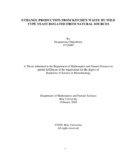| dc.contributor.advisor | Hossain, Mahboob | |
| dc.contributor.author | Chakraborty, Deepanwita | |
| dc.date.accessioned | 2021-03-08T04:54:45Z | |
| dc.date.available | 2021-03-08T04:54:45Z | |
| dc.date.copyright | 2020 | |
| dc.date.issued | 2020-02 | |
| dc.identifier.other | ID: 15136007 | |
| dc.identifier.uri | http://hdl.handle.net/10361/14323 | |
| dc.description | This thesis is submitted in partial fulfilment of the requirements for the degree of Bachelor of Science in Biotechnology 2020. | en_US |
| dc.description | Catalogued from PDF version of thesis. | |
| dc.description | Includes bibliographical references (pages 47-49). | |
| dc.description.abstract | It is time we think about changing to alternate fuel and make energy production procedures
greener. Bioethanol production by microbes is one step towards it. In this study, yeast from easily
available food sources was used to produce bioethanol by using domestic food waste as substrate.
This work was designed to bioconvert the lignocellulosic biomass to ethanol by the action of
yeast and bacteria. Grapes, cow dung, rice water, vegetable peels and soil were chosen to isolate
wild-type yeast for it to be the ethanol producing organism. The strain found went through
isolation, identification, stress tolerance tests and detailed characterization and optimization
before being used on inexpensive substrates to produce low cost ethanol. Considering all the
characteristics it was assumed that the strains isolated belonged to Saccharomyces spp. The
principal goal of this study was to produce ethanol at a low cost by the integration of highly
efficient yeast strain into the substrate that is considered as lignocellulosic household waste.
Optimization of fermentation was done at various temperature, pH, rotation per minute, substrate
size and the optimum fermentation condition was found to be at pH 6, 30°C, 120 rpm having
small cut substrates. An increase in the production was seen after the substrates were treated with
starch hydrolyzing and cellulolytic bacteria where the highest increase of ethanol production was
from 2.93 %v/v to 6.99 %v/v. These bacteria converted the complex carbohydrates to simpler
ones which the yeast utilized to produce the maximum amount of ethanol.
The maximum ethanol produced by yeast using vegetable peels was 6.99 %v/v after 48 hours of
incubation at 30°C, 120 rpm after bacterial treatment. This ethanol formed can be used as biofuel
as well as disinfectant which will reduce our dependence on fossil fuel which are polluting our
environment in a dangerous way. | en_US |
| dc.description.statementofresponsibility | Deepanwita Chakraborty | |
| dc.format.extent | 53 pages | |
| dc.language.iso | en_US | en_US |
| dc.publisher | Brac University | en_US |
| dc.rights | Brac University theses are protected by copyright. They may be viewed from this source for any purpose, but reproduction or distribution in any format is prohibited without written permission. | |
| dc.subject | Bioethanol | en_US |
| dc.subject | wild-type yeast | en_US |
| dc.subject | starch hydrolyzing and cellulolytic bacteria | en_US |
| dc.subject | Biofuel | en_US |
| dc.title | Ethanol production from kitchen waste by wild type yeast isolated from natural sources | en_US |
| dc.contributor.department | Department of Mathematics and Natural Sciences, Brac University | |
| dc.description.degree | B. Biotechnology | |

